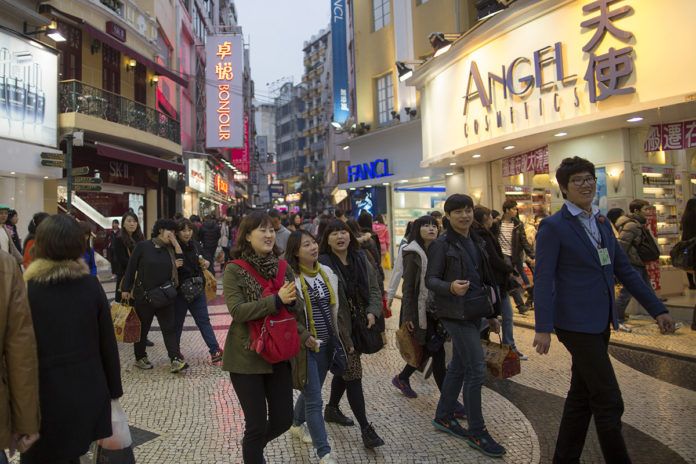The Macau Government Tourism Office (MGTO) expects Mainland Chinese tourism to continue to be the driving force behind the sector in the MSAR, and consequently the main driver of the local economy, according to information provided by MGTO to Business Daily.
Predictions are for the market share of mainland visitors to ‘maintain around 60-65 per cent of the total of visitors,’ for the 2017 year, notes the response to Business Daily’s enquiries.
This is in line with data from November on tourist arrivals by the Statistics and Census Service (DSEC), the most recent available, which demonstrates that 66.8 per cent of the total visitor arrivals to the territory over the course of the month – 1,705,721 visitors – were from the mainland, actually a 1.2 per cent drop year-on-year. The highest point in mainland visitation was seen in August of last year, when the number of mainland visitors reached 1.97 million, still a 5.5 per cent year-on-year drop however.
‘Mainland visitors came mostly from the Guangdong province, representing 44.4 per cent of total mainland visitors,’ notes the information, singling out ‘more new direct flight services’ between the mainland and the MSAR, and ‘ground transportation networks such as the high-speed rail’ as increasing visitor accessibility to the territory. However aside from ‘just the nearby Guangdong province’, the office notes another focus – to increase accessibility of ‘Mainland China second-tier cities’ such as Tianjin, Chengdu, Wuhan and other province capitals and coastal cities.
The department points out the overall increase in use of the Individual Visa Scheme by tourists, noting that ‘despite the big drop in the Mainland China visitor arrivals on package tours, more visitors prefer to travel’ to the MSAR under the scheme, which saw a 0.6 per cent drop year-on-year for the January to November 2016 period, as compared to a 22.3 per cent drop in package tours arrivals for the same period.
The build-up
MGTO plans to continue to promote the city’s heritage offerings with three new projects, currently or soon-to-be in Coloane: the Ka Ho houses; the shipyards and two cottages in Lei Chi Vun village – next to Coloane village; and the relocation of the Wine Museum to the island.
Another relates to the polemic new Grand Prix Museum, estimated to cost MOP300 million, and former headquarters of the Wine Museum.
A project announced in June of last year by Secretary for Social Affairs and Culture, Alexis Tam Chon Weng is the second project on the peninsula set for development this year – the renovation of two Portuguese-style houses into a memorial to local musician Xian Xinghai, projected for completion within two years.
These projects are banking on visitors spending more time in the MSAR ‘rather than just touring around and leaving on the same day,’ notes the information, and will be reliant on six main transportation and infrastructure projects.
The least visible of the six is the Guangdong Macau Passageway, which the government previously noted, in response to a written enquiry in March of last year by Legislator Chan Meng Kam, is still in the process of ‘exchanging opinions on the designs of the project’, and that ‘the two governments [Guangdong province and Macau] will strive to complete the project in 2019’. No progress has yet been mentioned this year.
The other five projects include the expansion of the Macau International Airport, the Hong Kong-Zhuhai-Macau bridge, the new land reclamation areas, and the two grossly over-budget infrastructure projects: the Taipa portion of the Light Rapid Transit System (LRT) and the new Taipa ferry terminal.
The group’s efforts, it notes, remain in line with the “Belt and Road Initiative”, with Macau set to act as a ‘major hub along the Maritime Silk Road,’ in particular through ‘“the cross border yacht sailing scheme’ between Macau and Zhongshan’.
When queried as to how to stimulate tourism given the decreased purchasing power of mainland visitors due to the devaluation of the yuan, the department noted six main areas, including: publicity (as evidenced by a recently announced single tourism campaign, called “Macao Travel Talk” to be placed on Hong Kong television group TVB’s channels, at a cost of MOP30.96 million); partnership marketing; use of high-speed rail connections to adjacent regions; cooperation with the mainland (whose tourism investment is set to reach RMB2 trillion – US$280 billion – this year, with predicted revenue to reach RMB7 trillion by 2020, according to the China State Council); enhancement of tourism service quality; and promoting smart tourism while diversifying existing tourism products.
Although there is no fixed date so far for the launch of the Macao Tourism Industry Development Master Plan, expectations are for a release date by the middle of this year, with the results of the public consultation sessions having been released on Tuesday.
























